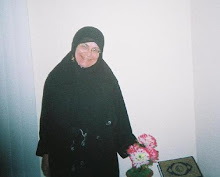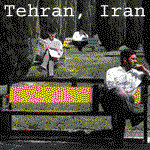The rich flavors of Palestine
by Mai M. Farsakh
Gaza City is among the most ancient and historic cities in the world. Napoleon Bonaparte described the city as the "Kings' Tunnel" and the "Gate between Africa and Asia," for it lies between the desert in the south and the Mediterranean climate in the north. Its strategic location, coupled with its fertile land, set the scene for Gaza becoming a prosperous trading market of world products. Today, Gaza remains an important city in its own right. It is the largest city in Palestine and is home to much of the Palestinian National Authority's administrative operations.
Gaza's geographic location is likewise reflected in its cuisine. Walking along Gaza's beaches, one is overwhelmed by the aroma of fresh seafood escaping from the numerous restaurants and public parks. Being situated on the Mediterranean Sea makes Gaza the ideal place to eat fresh fish. The day's menu comes directly from the sea and offers a selection of grilled, stewed or fried fish varieties.
Hebron is one of the most ancient cities in the Middle East and one of the oldest, continuously inhabited cities in the world. According to archaeological findings, Hebron was an ancient Canaanite royal city founded as early as the 3500 BC. Today, the old city of Hebron (characterized by its narrow and winding streets, flat-roofed stone houses and old bazaars) stands as a monument to its historic past.
Hebron's scenic backdrop of rolling hills which stretch out eastward to the desert provide stunning views of an ancient landscape of grapevines, olive trees, and villages. The beauty of its countryside is a testament to the fertility and productivity of its soil. Hebron is a land rich in resources. Grapes are the second largest fruit crop in the West Bank, the majority of which are cultivated in the Hebron district. Hebron is dotted with a plethora of vineyards which produce the delicious grapes for which Hebron is renowned. The grapes produced in Hebron are converted into jams, raisins and molasses and their leaves are utilized in the making of a signature Palestinian dish: stuffed grape leaves.
Neighboring Bethlehem, Beit Jala was founded as an old Canaanite city. Its name in Aramaic means "grass carpet." This ancient name is quite applicable today, for Beit Jala lies nestled among the lush green surroundings of olive and apricot trees. Its land produces a wide variety of traditional Palestinian crops, from olive trees to grape vineyards, but the town of Beit Jala is most famous for its delicious apricots and apricot jam. Likewise renowned for its apricots is the small scenic village of Jifna, located near Birzeit. Previously known as Gophna of Josephus, Jifna was once a Roman-Byzantine regional capital. Today it is enjoyed for its serenity and variety of fine outdoor restaurants. Each year during late spring, hundreds flock to Jifna's Apricot Festival to enjoy the fruit's brief but savory season.
Dating back more than 10,000 years, Jericho is the oldest inhabited city in the world. Settlements have been excavated dating to the Early Bronze Age (9000 BC). Historically known as the "City of Palms," ancient Jericho witnessed the domestication of plants and animals a thousand years prior to Mesopotamia or Egypt. To this day, its moderate climate, fertile land and ability to produce fresh fruits and vegetables year round make Jericho a valuable agricultural area. Among its most famous agricultural products are dates, bananas and citrus fruits.
"The Uncrowned Queen of Palestine," as Nablus is called by historians, was founded in 72 AD by the Roman Emperor Titus. It was named Neapolis, the "New City," which later became Nablus. The city was erected upon a fertile valley nestled between two mountains. Today Nablus is a principal industrial and commercial centre and is among the largest cities in the West Bank. The lively Old City is lined with shops selling Palestinian sweets such as knafeh, baklawa and burma. Nablus is most famous for its knafeh, a Palestinian culinary specialty consisting of white goat cheese, pastry, and syrup served in hot square slices.
Much of the Palestinian landscape is adorned with hand-built terraces and olive orchards which can be traced back to over six thousand years ago. Stone presses have been excavated in the region dating back to the Stone Age. The millennia-old tradition of olive harvesting has been passed down through the generations. Today, olive harvesting remains as celebrated an event as ever in Palestine. Harvesting, which takes place in late October and early November, is a family affair and a major community event. Entire towns can be seen toiling in the fields and the olive presses. Even school children are given a holiday to participate in this time-honored activity.
Palestinian olives and olive oil are renowned for their distinct tastes and flavors. The majority of irrigated olive orchards are found in the northern West Bank region, particularly the Tulkarm district. Taste, color and yield may differ from valley to valley and even from one side of a mountain to the other (as a result of variations in sun and wind exposure). For instance, olive oil produced in the Tulkarm district is medium bodied and greenish in color, while the Ramallah area produces oil lighter in consistency and more yellow in color.
Jenin, the ancient city of Ginaea is located north of Nablus, on the slopes of a hill nestled among the picturesque surrounds of fig and palm trees. Its fertile lands produce a variety of fruits and vegetables. Jenin is well-known for its delicious watermelons. Archaeological findings indicate that watermelons have been grown in Palestine since about 2000 BC. Watermelons were valued as a source of water during dry periods. They are likewise a source of refreshment during the hot Palestinian summers of today.
Though small in size, Palestine is vast in its array of terrain. Palestine's diverse landscape is translated into a wide palate of flavors: from the fresh seafood of Gaza's beaches to the olive oil harvested from among Tulkarm's terraced hillsides. It is among this eclecticism that Palestine has found a flavor of its own.
Labels: History, Palestine, Palestinian Culture

















0 Comments:
Post a Comment
<< Home